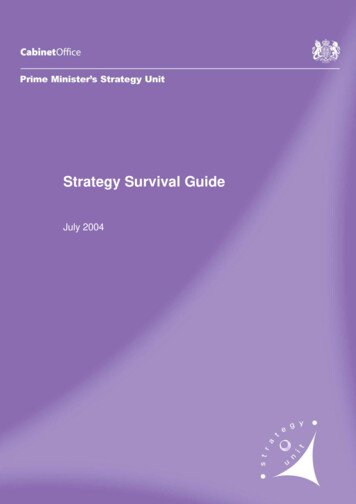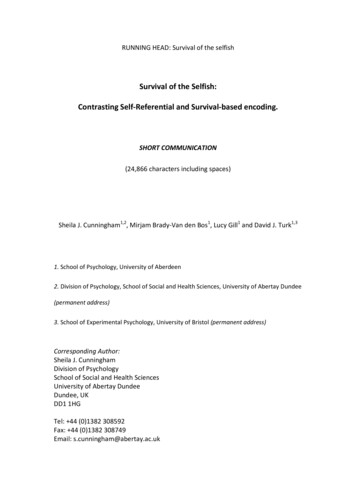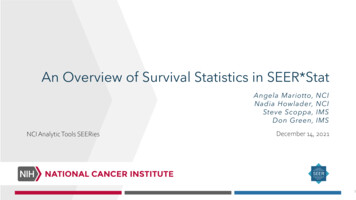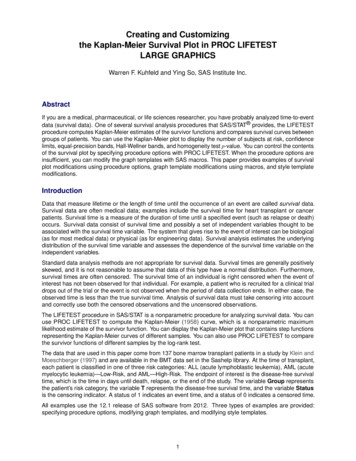
Transcription
StrategyStrategySurvivalSurvivalGuideGuideJuly 2004July 2004
Strategy Survival GuideVersion 2.1Prime Minister’s Strategy Unithome strategy development strategy skills site indexHomeThe Strategy Survival Guide aims to support strategy development and promote strategic thinking ingovernment. It encourages a project-based approach to developing strategy and describes four typicalproject phases. It also discusses a range of skills and useful tools and approaches that will help to fosterstrategic thinking across government. It is offered as a resource and reference guide, and not intended asa prescription or off-the-shelf solution to successful strategy work.The Strategic Capability Team at the Prime Minister’s Strategy Unit exists to support governmentdepartments in understanding and applying the content of the guide.Strategy DevelopmentStrategy SkillsTypical tasks and outputs of eachphase of a strategy projectUseful tools and approaches forthinking strategically Site Index - a full index of the guide Introducing Strategy - an introduction to strategy and strategic thinking How to Use the Guide - tips to help you find what you need About Us - background to the Strategy Unit Register - we’ll inform you when the guide is updatedThe Strategy Survival Guide is work in progress. The Strategy Unit would welcome your comments and suggestions.Published: July 2004Last updated: 01.07.2004Strategy Survival GuidePage 1
Strategy Survival GuideVersion 2.1Prime Minister’s Strategy Unithome strategy development strategy skills site indexSite IndexHome1Site Index2Introducing Strategy5How to use the Guide10About Us11Contact Us & Registration12Strategy Development13Justification & Set Up14Task: Justifying the project15Task: Clarifying the issues16Task: Planning the project17Task: Setting up the team18Output: Project proposal & plan19Management issues20Questions to ask21Research & Analysis22Task: Gathering knowledge23Task: Analysing knowledge24Task: Reviewing delivery capability25Output: Interim analytical report26Management issues27Questions to ask28Strategic Direction Setting29Task: Developing guiding principles30Task: Articulating a vision31Task: Defining strategic aims and objectives32Output: Preferred strategic direction33Management issues34Questions to ask35Strategy Survival GuidePage 2
Policy & Delivery Design36Task: Developing policy options37Task: Detailing policy options38Task: Appraising policy options39Task: Planing the roll out40Output: Final report & delivery plan template41Management issues42Questions to ask43Strategy Skills44Managing People and the Project45Recruiting a team in practice46Building a team in practice49Working as a team in practice51Encouraging creativity in practice56Giving & receiving feedback in practice61Developing the plan in practice64Structuring the work in practice66Setting milestones in practice68Managing risks in practice70Defining accountability in practice72Evaluating the project in practice74Managing Stakeholders and Communications76Identifying key stakeholders and their issues in practiceEffectively engaging with stakeholders in practiceDeveloping a stakeholder engagement plan77 template79 template82Drawing up a communications plan in practice83Communication with the media in practice85Evaluating communicationsPreparing presentations86 in practice87Structuring the Thinking90Issue trees in practiceFirst principles thinking in practice94Systems thinking in practice96SWOT in practice101PESTLE in practice104Creativity techniques in practice107Strategy Survival GuidePage 3 template91
Building an Evidence Base113Data types & sources in practice114Surveys in practice118Interviews & focus groups in practice126Modelling in practice129Market analysis in practice136Organisational analysis in practiceInternational comparisons in practice146Benchmarking in practice151Forecasting in practice154Scenario development in practice158Counterfactual analysis in practice165Appraising Options template142168Multi-criteria analysis in practice169Cost-benefit & cost-effectiveness analysis in practice174Rationale for government intervention in practice178Planning Delivery181Change management in practice182Institutional change in practice186Designing an implementation plan in practice188AppendixExternal Links191Templates196Subject Index201Strategy Survival GuidePage 4
Strategy Survival GuideVersion 2.1Prime Minister’s Strategy Unithome strategy development strategy skills site indexIntroducing StrategyAn Introduction to Strategy in GovernmentStrategies help organisations think through what they want to achieve and how they will achieve it. Puttingstrategies into practice and acting strategically ensures that they are focused on the things that really matter– not buffeted by events or short-term distractions – and are able to allocate their resources accordingly.There is a huge literature on strategy in business and in warfare; strategy in government is similar, but tendsto be more complex. It generally involves multiple goals rather than one single bottom line and it isimplemented through a wide range of policy instruments, including laws, taxes and services. Far from beinga neat linear process, it is shaped by unexpected events and political pressures. It also often needs to bemore visible and accountable than strategy in other fields.As a rule, the best strategies in governments and public services are: clear about objectives, relative priorities and trade-offs underpinned by a rich understanding of causes, trends, opportunities, threats and possible futures based on a realistic understanding of the effectiveness of different policy instruments and thecapacities of institutions (strategies that work well on paper but not in practice are of little use) creative - designing and discovering new possibilities designed with effective mechanisms for adaptability in the light of experience developed with, and communicated effectively to, all those with a stake in the strategy or involved inits funding or implementation.Strategies vary greatly. Some are very precisely defined and imposed top-down through organisationalhierarchies. Others emerge in a more evolutionary and co-operative way from discussions, experiments andlearning.In either case, taking a strategic approach should ensure that decisions on strategic direction, policy designand delivery are seen as an end-to-end process of change management, with constant testing, feedback,learning and improvement. In a democracy, the end purpose will be to create public value – services andoutcomes that are valued by the public. Policies need to be developed within the framework of a longer-termstrategy, taking into account the practicalities of implementation. All strategies need to be adaptable, withquick feedback and effective information flows to respond to new information, and take account of changingcircumstances or unexpected events.public and user feedbackconsultation and engagementHigh levelgoalsTrends andfuturesContext andconstraintsStrategic DirectionPolicy DesignDeliveryMeasurement and analysistesting, piloting and continuouslearningAdaptabilityStrategy Survival GuidePage 5Outcomes
A Framework for Strategic DirectionA strategy needs to provide a clear sense of direction – based on analysis of different strategic choices andtheir implications. Defining the strategic direction or desired way forward will often involve a vision, togetherwith aims and short, medium and long term objectives that provide a coherent and consistent framework forco-ordinating government activity: a vision is a statement of aspirations describing a desired future aims are the outcomes needed to bring about that desired future objectives are those things that need to be achieved in order to realise these outcomes.An example from a Strategy Unit project is set out below:AimsVisionStrategic Framework - SU Ethnic Minorities and the Labour Market ProjectIn ten years’ time, ethnic groups living in Britain should no longer face disproportionate barriers to accessing andrealising opportunities for achievement in the labour marketBuilding EmployabilityObjectives Raising educational attainment Ensuring that key groups arebenefiting from educationalreformsConnecting People with Work Streamlining outreachinitiatives Tailoring labour marketprogrammes to client needs Extending programme flexibility Increasing housing mobilityEqual Opportunities in theWorkplace Advising and supportingemployers’ awareness andaction Increasing efficacy of existingequal opportunity levers Increasing transparency andawareness Increasing vocational skills Addressing access to childcareand transport needsIn addition to a framework setting out strategic direction, strategies need to provide evidence-based policyrecommendations to act as a clear route map of how the objectives will be delivered. Examples of strategiesdeveloped across a broad range of government policy areas can be found on the Strategy Unit’s website.The Relationship Between Strategy and PolicyThe terms strategy and policy are used in many different ways, and sometimes interchangeably. For thepurposes of this guide, the following definitions are used: Strategy is the overall process of deciding where we want to get to and how we are going to getthere. Strategic direction describes the desired future and sets out what needs to be achieved in order tobring it about. It provides the guiding principles that give context and coherence to action. Policy provides the means of moving in that direction – and often a number of policies need to worktogether to deliver particular strategic outcomes. Policy design work is concerned with identifyinghow to achieve strategic objectives, selecting the most suitable policy instruments for doing this, anddetailing how these instruments will work in practice.The relationship between strategy and policy is very close, and should be highly interactive. Strategiesshould be developed together with a realistic idea of how they might be realised, and policies should existwithin a strategic framework that explains how they contribute to desired outcomes.Divorcing strategy and policy creates the risk of setting unachievable strategic objectives and allowing policyprogrammes to develop legitimacy from their longevity rather than their contribution to meeting public needs.Close integration will help to ensure that strategies are implemented using the most suitable policies, andthat different policies are not contradictory, but work together towards strategic outcomes.Strategy Survival GuidePage 6
The Relationship Between Strategy and DeliveryStrategies and policies that are not deliverable are of little use. Strategy work needs to involve frontlinepractitioner knowledge from the outset, and proceed grounded in a realistic understanding of deliverycapability. Feedback mechanisms are needed from delivery back into strategy and policy design in order tocreate adaptable learning systems that can evolve in the light of experience and unexpected results.Questions for Strategy DevelopmentAs the underlying framework that guides government thinking and action, strategy is concerned with askingand answering a number of questions. The diagram below demonstrates that while strategic issues may behighly complex and ambiguous, the questions at the heart of strategy development are searching yetfundamentally simple. This in no way detracts from how difficult it can be to answer these key questions, butprovides a valuable anchor at times when the complexity is overwhelming.What is theissue?Where are wenow and whereare we going?Where do wewant to get to?How do we getthere?Who do we have to involve - and how?What tools and techniques should we use?The first four questions (across the top of the diagram) cut to the heart of strategy development byestablishing an understanding of the world as it is today and determining the desired state of the future. Thefurther two questions (underpinning the process) recognise that effective strategy development can not occurin either an ivory tower or black box, but must occur collaboratively using open and transparent methods andapproaches. These questions are closely mirrored by the typical phases of a strategy development projectand highlight the importance of the full range of strategy skills.Components of a Strategic ApproachIn practice, strategic thinking may not be as linear as the above questions suggest, but may involve a moreiterative consideration of a number of key components.Vision &ValuesEvidence &AnalysisFirst PrinciplesDeliveryCapabilityStakeholders Vision & Values: a vision of the desired state of the future founded on government’s wider valuesand principles, that sets priorities, recognises trade-offs and describes the relationship to and fit withstrategy in other policy areas.Evidence & Analysis: an understanding of the current situation, trends and likely states of thefuture, together with their drivers and causes, and a realistic evaluation of the effectiveness ofdifferent policy instruments. This should be based on a broad evidence base including economics,science, social research, statistics etc. and placed within a context of benchmarks and internationalcomparisons.Stakeholders: a deep appreciation of their views, concerns and perspectives and a plan for howthey should be involved in strategy and policy development, and the role they may play in delivery.Delivery Capability: an evaluation of the delivery system, and the culture and available resources oforganisations within it, that highlights potential barriers to change and successful delivery.Strategy Survival GuidePage 7
These four components need to be considered objectively from first principles to identify the real issues,challenge implicit assumptions and question existing approaches.A development in any one of the components may provide the initial impetus for fresh strategic thinking anddrive a need to develop thinking in the other components. In the same way, strategy development is often aniterative process with the components developing and evolving in response to each other.Strategic Solution GenerationImplicit in adopting a strategic approach is a rational and reasoned process for developing solutions. Incontrast to an ad-hoc approach that is likely to result in a more ‘random’ set of solutions, a strategicapproach is underpinned by guiding principles and a set of appraisal criteria that frame the generationand appraisal of alternative options.StageRandom ‘solution’ generationStrategic solution generationInitial problemResearch &analysisRange of possiblesolutionsiples&CrOptionappraisalScattergun ces andtrade-offsCoherent solutionsThe appraisal criteria that should be used for this process are applicable to all decisions about governmentaction, and address the suitability, feasibility and acceptability of each option: Suitability – do the proposed actions address the key issues and will they be able to deliver desiredoutcomes? Feasibility – can the proposed actions be delivered with the potential system capabilities andresources? Acceptability – is there sufficient political and public support to legitimise the proposed actions?Maintaining a Strategic PerspectiveThe need for strategic thinking extends far beyond the realms of a formal strategy development project. At allstages of policy design and delivery, a strategic perspective is needed to ensure that government action isfocused on and capable of meeting the true needs of the public. The questions posed by the three criteria ofsuitability, feasibility, and acceptability form the basis of such a strategic perspective.Is itSuitable?StrategicThinkingIs itFeasible?Is itAcceptable?Strategy Survival GuidePage 8
In a dynamic world, public managers and policymakers need a strategic perspective to keep these three keyquestions in mind, and act to redress any gaps:Suitability GapSFAA suitability gap is created when public service actions and approaches are nolonger a suitable response to public needs. This may occur for reasons including: the original problem or need has changed or resolved tensions arise with other strategic objectives or priorities new evidence informs a change in overall desired outcomes escalating or unacceptably high adverse impacts become apparent.When public policy is no longer adding value, a strategic perspective is needed tochallenge the suitability of actions and reallocate resources to address prevalentneeds.Feasibility GapSFAA feasibility gap is created by an inability to deliver desired outcomes. Thissituation may arise for many reasons, including: underestimation or unavailability of the resources and capabilities neededto address the key issues inconclusive evidence for how to address the key issues insufficient incentives for innovation, transfer of best practice andcontinuous improvement in the system diminishing returns requiring disproportional effort to extract benefitbeyond the initial quick wins.In this instance, a strategic perspective is needed to align spending with strategicpriorities, and develop a more capable delivery organisation or system.Alternatively, if the feasibility gap is too large, there may be a case for challengingthe strategic objectives in favour of more realistic goals.Acceptability GapSFAAn acceptability gap is created by the absence of sufficient political or publicsupport to legitimise action. This can occur for reasons including: a lack of public engagement in strategy development, including a lack ofunderstanding of the need for change changes in the environment leading to shifting views about the strategy innovative front-line organisations responding to public needs andevolving beyond their original remit.A strategic perspective encourages effective stakeholder engagement and astrong evidence base that demonstrates the problem and the suitability of theproposed action for addressing it. Strategies also need to be adaptable enough toencourage innovation and entrepreneurialism in meeting public needs.Building Strategic CapabilityBuilding strategic capability, both in terms of the ability to develop strategies and the ability to maintain astrategic perspective in day to day operations, requires a focus on creating: demand for better strategy work from Ministers, CEOs, Directors, and senior officials a culture of bottom-up challenge and ‘rocking the boat’ that encourages strategic thinking organisational structures and processes which reinforce demand for a strategic approach a strong evidence base that provides an accurate understanding of issues and how to respond them skilled and confident people with diverse experience and access to best practice resources.ReferencesThe Strategy Unit discussion paper Creating Public Value describes the concept of public value, and how itcan be used to think about the goals and performance of public policy.Strategy Survival GuidePage 9
Strategy Survival GuideVersion 2.1Prime Minister’s Strategy Unithome strategy development strategy skills site indexHow to Use the GuideThe guide is structured around two sections. The Strategy Development section discusses the process ofconducting a strategy project and the Strategy Skills section addresses the skills that are required forsuccessful strategy work.An OverviewFor the new user, the best way to get an overview of the content of the guide is to read the IntroducingStrategy section and the summary pages for each of the project phases and strategy skills as set out below:Strategy Development Justification & Set Up Research & Analysis Strategic Direction Setting Policy & Delivery DesignStrategy Skills Managing People and the Project Managing Stakeholders & Communications Structuring the Thinking Building an Evidence Base Appraising Options Planning DeliveryThe Strategy Development SectionHaving read the summary pages for the four project phases, a more in-depth understanding of any particularphase can be developed by reading through a number of more detailed pages. Each summary pageprovides links to the following detail: typical tasks example outputs management issues that should be considered typical questions that should be asked relevant skills.The Strategy Skills SectionThe summary page for each strategy skill contains links to a number of helpful tools and approaches.Together these make up a ‘toolkit’ for the strategy practitioner – using the right tool for the job will help toimprove the efficiency and effectiveness of strategy work.‘In practice’ examples are provided to illustrate how each tool or approach has been applied in recentstrategy work, and references are provided for those wishing to find further information. Where appropriate,blank templates are also provided.Other Sources of Government GuidanceThe Strategy Survival Guide aims to support strategy development and strategic thinking. Further sources ofguidance for those responsible for taking strategies forward into policy design and delivery include: The Green Book from HMT – supporting the appraisal of proposals and evaluation of activities Policy Hub and the Magenta Book from GCSRO – encouraging the use of research and evidencein policy making Successful Delivery Toolkit and Gateway Process from OGC – supporting the management ofprocurement and delivery programmes and projects.Strategy Survival GuidePage 10
Strategy Survival GuideVersion 2.1Prime Minister’s Strategy Unithome strategy development strategy skills site indexAbout UsHistory of the Strategy UnitThe Prime Minister’s Strategy Unit is part of the Cabinet Office. It was formed to provide a clear focus forstrategic thinking and policy analysis at the heart of government. It formally began operating in July 2002through a merger of the Performance and Innovation Unit, the Prime Minister's Forward Strategy Unit, andpart of the Policy Studies Directorate of the Centre for Management and Policy Studies. The Unit reports tothe Prime Minister through the Cabinet Secretary.The Strategy Unit has four main roles: undertaking long-term strategic reviews of major areas of policy undertaking studies of cross-cutting policy issues working with departments to promote strategic thinking and improve policy making across Whitehall providing strategic leadership to social research across government.The Unit’s Approach to Strategy DevelopmentThe Unit has a project based approach to developing strategy. Most projects are announced to Parliamentand short papers outlining the scope of each project and project reports (including those produced by thePerformance and Innovation Unit) are published on the Strategy Unit website. Teams are tailored to theneeds of each project. Most are small multi-disciplinary teams that bring together civil servants and a widerange of people from outside government, including those responsible for implementation and delivery.Based on the belief that rigorous analysis is an essential foundation for strategy development, the unitfosters an evidence-based approach. It also promotes an open approach believing that involving peopleearly on greatly increases the prospects of sustainable change.The Strategic Capability TeamEstablished in 2003, the Strategic Capability Team are dedicated to fulfilling the Strategy Unit’s remit to workwith departments to promote strategic thinking and improve policy making. In addition to publishing thisguide and promoting strategy best practice through coaching, training and networks, the team are focusedon working with departments to help them assess and improve their ability to create implementable strategyand meet their most important strategic challenges.Government Chief Social Researcher's OfficeThe Government Chief Social Researcher's Office (GCSRO) was set up in October 2002 to provide strategicleadership to social research across government. It aims to co-ordinate research planning and access toresearch knowledge across government, and ensure high skill levels and quality standards.Strategy Survival GuidePage 11
Strategy Survival GuideVersion 2.1Prime Minister’s Strategy Unithome strategy development strategy skills site indexContact Us & RegistrationRegister To Receive UpdatesThe Strategy Survival Guide is work in progress and is updated at regular intervals. If you would like to benotified when a new version of the guide is published please register your details.The Strategy UnitThe Strategy Unit is based in Admiralty Arch in London. General enquiries should be directed to:Strategy Unit4th FloorAdmiralty ArchThe MallLondon SW1A 2WHstrategy@cabinet-office.x.gsi.gov.uktel: 020 7276 1881Strategy Survival GuidePage 12
Strategy Survival GuideVersion 2.1Prime Minister’s Strategy Unithome strategy development strategy skills site indexStrategy DevelopmentEffective strategy development requires the mandate to challenge, the space to think and the commitment ofstakeholders. For these, and many other reasons, strategy work is best undertaken within the context of aclearly defined project that can act as a focal point for generating momentum behind a change inconventional thinking.Although the process of developing strategy is complex and often iterative in nature, strategy projects tend tonaturally move through a number of phases. The framework below describes these phases together withtypical tasks and example outputs. The management issues and questions that often arise at each phaseare also highlighted.The framework provides a helpful reference point but should not be interpreted as a template. In practice thephases are unlikely to be entirely discrete and sequential, tasks may actually span across phases, andphases may need to be revisited as the true complexity of the project unfolds.PhasesJustification& Set UpResearch &AnalysisStrategicDirectionSettingPolicy &DeliveryDesignTasks Justifyingthe project Gatheringknowledge Clarifyingthe issues Analysingknowledge Planing theproject Reviewingdeliverycapability Setting upthe team Developingguidingprinciples Developingpolicyoptions Articulatinga vision Detailingpolicyoptions Definingstrategicaims andobjectives Appraisingpolicyoptions Planing theroll outOutputsProjectproposal ctionFinal report& deliveryplan managementissues managementissues managementissues managementissues questions questions questions questionsStrategy Survival Guide – Strategy DevelopmentPage 13
Strategy Survival GuideVersion 2.1Prime Minister’s Strategy Unithome strategy development strategy skills site indexStrategy Development Justification & Set UpPhaseJustification& Set UpTasks Justifyingthe project Clarifyingthe issues Planing theproject Setting upthe teamOutputProjectproposal &plan typical managementissues in this phase key questions to askin this phaseAs the need for fresh strategic thinking starts to emerge, it is important tobring clarity to the scope, rationale and approach for the proposed work.At this early stage it is important to: demonstrate the need for the project identify and structure the issues that need to be addressed plan how the project will be structured pull together an appropriate team.Justifying the need for the project is key to securing buy-in from stakeholdersand generating momentum behind the need to challenge conventionalthinking. This will require a close examination of the issues in order to defineand agree the scope of the project. It is also helpful at this stage to identify aMinister or senior official that can act as the project’s sponsor.Clarifying the issues to be addressed will also help to highlight logicalworkstreams for the project and hence necessary roles and responsibilitieswithin the team. This should be documented in a project plan along with acommitment to particular outputs and milestones, an assessment of risks tothe project’s successful completion, and a description of the proposedproject governance structure. Even at this early stage the project plan shouldbe accompanied by a plan for stakeholder engagement and acommunications strategy.Throughout this phase it will become increasingly clear what kind of projectteam will be needed. By the end of the phase a team should be in place thatis large enough to handle the expected workload, has all the necessary skillsand experience and is acceptable to all the key stakeholders.It can take a significant amount of time to clarify and agree the issues to beaddressed with stakeholders, to agree the project budget and to recruit theright team. As a result this phase can often take longer than initiallyexpected. It is however a crucial foundation for the rest of the project andplenty of time should be allowed for it.Skills relevant to this phase include: structuring the thinking managing people and the project managing stakeholders and communicationsStrategy Survival Guide – Strategy DevelopmentPage 14
Strategy Survival GuideVersion 2.1Prime Minister’s Strategy Unithome strategy development strategy skills site indexStrategy Development Justification & Set Up TasksJustifying the projectBefore embarking on a project, it is important to define and justify the need for the project. This helps toassess whether the right questions are being asked, whether a review can really add value, whethersomeone else should lead it, and whether the timing is right. Rigor at this stage pays substantial dividendslater on.The justification exercise should: define the problem to be addressed articulate the vision and values driving the need for the project identify work that has been done to date on this issue consider whether there is a clear rationale for government intervention assess the feasibility of having an impact on the
Strategy Survival Guide Page 1 The Strategy Survival Guide aims to support strategy development and promote strategic thinking in government. It encourages a project-based approach to developing strategy and describes four typical project phases. It also discusses a range of skills and useful tools and approaches that will help to foster






![[ST] Survival Analysis - Stata](/img/33/st.jpg)



